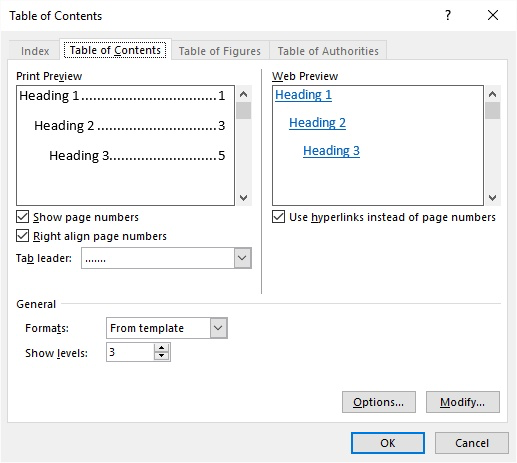Please Note: This article is written for users of the following Microsoft Word versions: 2007, 2010, 2013, 2016, 2019, 2021, and Word in Microsoft 365. If you are using an earlier version (Word 2003 or earlier), this tip may not work for you. For a version of this tip written specifically for earlier versions of Word, click here: Creating a Table of Contents from Heading Levels.
Written by Allen Wyatt (last updated December 16, 2023)
This tip applies to Word 2007, 2010, 2013, 2016, 2019, 2021, and Word in Microsoft 365
If you are writing a long document or a book, you may want to create a Table of Contents (TOC) for your document. The easiest way to create a TOC is to use heading levels, as defined by the Word styles. To do this, follow these steps:

Figure 1. The Table of Contents tab of the Table of Contents dialog box.
Note, again, that this process creates a TOC based on heading levels within your document. This means that your document must use heading styles throughout it. (Heading styles are named "Heading 1," "Heading 2," etc.) If you apply these as you are creating your document—or if you go back and apply the styles later—then creating the TOC is a snap, as described above.
WordTips is your source for cost-effective Microsoft Word training. (Microsoft Word is the most popular word processing software in the world.) This tip (5950) applies to Microsoft Word 2007, 2010, 2013, 2016, 2019, 2021, and Word in Microsoft 365. You can find a version of this tip for the older menu interface of Word here: Creating a Table of Contents from Heading Levels.

Create Custom Apps with VBA! Discover how to extend the capabilities of Office 365 applications with VBA programming. Written in clear terms and understandable language, the book includes systematic tutorials and contains both intermediate and advanced content for experienced VB developers. Designed to be comprehensive, the book addresses not just one Office application, but the entire Office suite. Check out Mastering VBA for Microsoft Office 365 today!
Insert a table of contents in your document, and your page numbering may get thrown for a loop. If you want the page ...
Discover MoreWhen you create a Table of Contents for a document that contains multiple sections, the page numbers in that TOC should ...
Discover MoreLinda's got a document that includes a table of contents that is based on headings in the document. When the headings ...
Discover MoreFREE SERVICE: Get tips like this every week in WordTips, a free productivity newsletter. Enter your address and click "Subscribe."
There are currently no comments for this tip. (Be the first to leave your comment—just use the simple form above!)
Got a version of Word that uses the ribbon interface (Word 2007 or later)? This site is for you! If you use an earlier version of Word, visit our WordTips site focusing on the menu interface.
Visit the WordTips channel on YouTube
FREE SERVICE: Get tips like this every week in WordTips, a free productivity newsletter. Enter your address and click "Subscribe."
Copyright © 2026 Sharon Parq Associates, Inc.
Comments